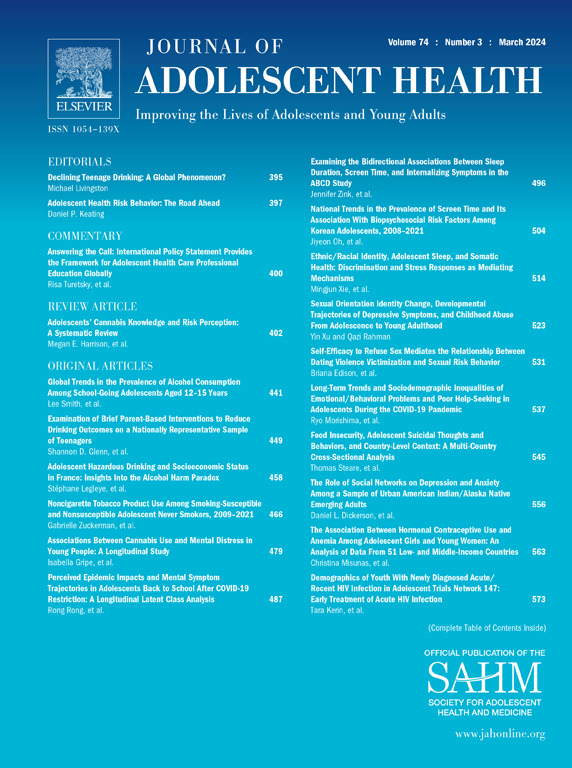一项旨在改善青少年和年轻男性急诊科患者性健康的数字干预随机对照试验。
IF 5.5
2区 医学
Q1 PEDIATRICS
引用次数: 0
摘要
目的:评估为改善青少年和年轻成年人(AYA)男性性健康而开发的基于理论的用户知情数字健康干预措施的实施结果和潜在疗效:我们对 14-21 岁的性活跃男性急诊科(ED)患者进行了试点随机对照试验。参与者被随机分配到干预措施(Dr. Eric,急诊室干预改善护理)或常规护理中。埃里克医生 "由一款基于急诊室的性健康应用程序和为期 3 个月的互动短信组成。我们对用户的可行性、采用率和忠诚度进行了评估。避孕套使用率是主要疗效指标,其定义是过去 4 周内使用避孕套的性接触次数除以性接触总次数:我们招募了 119 名患者;平均年龄为 17.9 岁,87% 为西班牙裔,半数患者在最后一次性交时使用了安全套。埃里克医生证明了其可行性,同意率(86.2%)和随访率(81.5%)都很高。干预参与者认为埃里克医生是可以接受的,他们喜欢(86.2%)并推荐(87.9%)该计划。98%的干预参与者与所有五个应用程序模块进行了互动;四分之一的干预参与者选择不发送短信。在 6 周的随访中,干预组比对照组更经常使用安全套[OR 3.57,95% 置信区间 (1.93, 6.60)],p < .001];但这一显著差异在 13 周时并未持续:埃里克医生 "是一种可行的分娩方式,男性青壮年患者也能接受。据我们所知,"艾瑞克医生 "是首个证明短期疗效的干预措施,可改善急诊室男性青壮年使用安全套的情况。本文章由计算机程序翻译,如有差异,请以英文原文为准。
A Randomized Controlled Trial of a Digital Intervention to Improve the Sexual Health of Adolescent and Young Adult Male Emergency Department Patients
Purpose
To assess implementation outcomes and potential efficacy of a user-informed, theory-based digital health intervention developed to improve adolescent and young adult (AYA) male sexual health.
Methods
We conducted a pilot randomized controlled trial of sexually active male emergency department (ED) patients aged 14–21 years. Participants were randomized to the intervention (Dr. Eric, Emergency Room Interventions to improve Care) or usual care. Dr. Eric consists of an ED-based sexual health app followed by 3 months of interactive text messages. We assessed the feasibility, adoption, and fidelity among users. Condom use, defined as the number of sexual encounters with condoms divided by the total number of sexual encounters over the past 4 weeks, was the primary efficacy outcome.
Results
We enrolled 119 patients; mean age was 17.9 years, 87% were Hispanic, and half used condoms at last intercourse. Dr. Eric demonstrated feasibility, with high rates of consent (86.2%) and follow-up (81.5%). Intervention participants found Dr. Eric acceptable, liking (86.2%) and recommending (87.9%) the program. 98% of intervention participants interacted with all five app modules; one-quarter opted out of text messaging. At 6-week follow-up, the intervention group more often used a condom compared to the control group [OR 3.57, 95% confidence interval (1.93, 6.60)], p < .001]; however, this significant difference did not sustain at 13 weeks.
Discussion
Dr. Eric was feasible to deliver and acceptable to male AYA patients. To our knowledge, Dr. Eric is the first intervention to demonstrate evidence of short-term efficacy for improving condom use among male AYA in the ED.
求助全文
通过发布文献求助,成功后即可免费获取论文全文。
去求助
来源期刊

Journal of Adolescent Health
医学-公共卫生、环境卫生与职业卫生
CiteScore
10.40
自引率
3.90%
发文量
526
审稿时长
46 days
期刊介绍:
The Journal of Adolescent Health is a scientific publication dedicated to enhancing the health and well-being of adolescents and young adults. Our Journal covers a broad range of research topics, spanning from the basic biological and behavioral sciences to public health and policy. We welcome a variety of contributions, including original research papers, concise reports, literature reviews, clinical case reports, opinion pieces, and letters to the editor. We encourage professionals from diverse disciplines such as Anthropology, Education, Ethics, Global Health, Health Services Research, Law, Medicine, Mental and Behavioral Health, Nursing, Nutrition, Psychology, Public Health and Policy, Social Work, Sociology, and Youth Development to share their expertise and contribute to our mission of promoting adolescent health. Moreover, we value the voices of young individuals, family and community members, and healthcare professionals, and encourage them to submit poetry, personal narratives, images, and other creative works that provide unique insights into the experiences of adolescents and young adults. By combining scientific peer-reviewed research with creative expressions, our Journal aims to create a comprehensive understanding of the challenges and opportunities in adolescent and young adult health.
 求助内容:
求助内容: 应助结果提醒方式:
应助结果提醒方式:


